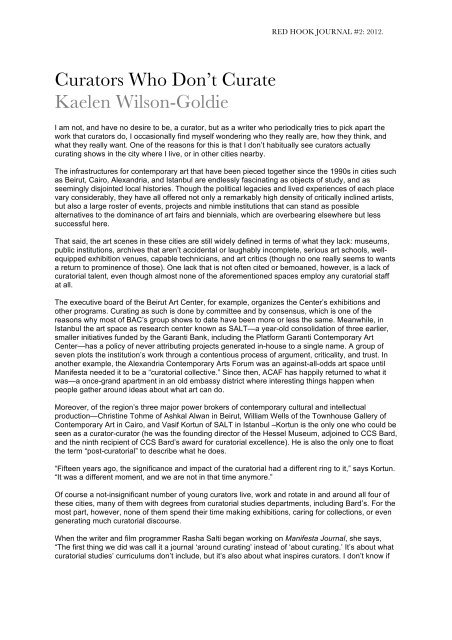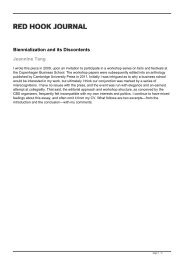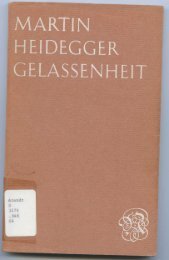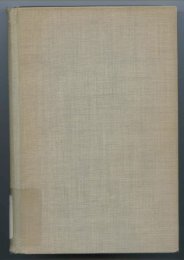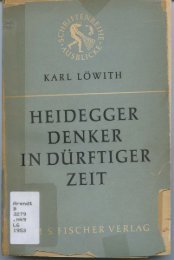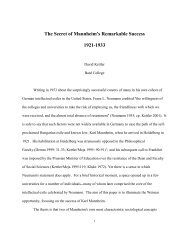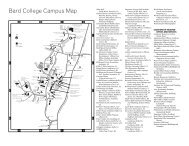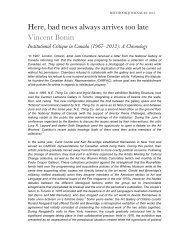Curators Who Don't Curate Kaelen Wilson-Goldie
Curators Who Don't Curate Kaelen Wilson-Goldie
Curators Who Don't Curate Kaelen Wilson-Goldie
You also want an ePaper? Increase the reach of your titles
YUMPU automatically turns print PDFs into web optimized ePapers that Google loves.
<strong>Curators</strong> <strong>Who</strong> Don’t <strong>Curate</strong><br />
<strong>Kaelen</strong> <strong>Wilson</strong>-<strong>Goldie</strong><br />
RED HOOK JOURNAL #2: 2012.<br />
I am not, and have no desire to be, a curator, but as a writer who periodically tries to pick apart the<br />
work that curators do, I occasionally find myself wondering who they really are, how they think, and<br />
what they really want. One of the reasons for this is that I don’t habitually see curators actually<br />
curating shows in the city where I live, or in other cities nearby.<br />
The infrastructures for contemporary art that have been pieced together since the 1990s in cities such<br />
as Beirut, Cairo, Alexandria, and Istanbul are endlessly fascinating as objects of study, and as<br />
seemingly disjointed local histories. Though the political legacies and lived experiences of each place<br />
vary considerably, they have all offered not only a remarkably high density of critically inclined artists,<br />
but also a large roster of events, projects and nimble institutions that can stand as possible<br />
alternatives to the dominance of art fairs and biennials, which are overbearing elsewhere but less<br />
successful here.<br />
That said, the art scenes in these cities are still widely defined in terms of what they lack: museums,<br />
public institutions, archives that aren’t accidental or laughably incomplete, serious art schools, wellequipped<br />
exhibition venues, capable technicians, and art critics (though no one really seems to wants<br />
a return to prominence of those). One lack that is not often cited or bemoaned, however, is a lack of<br />
curatorial talent, even though almost none of the aforementioned spaces employ any curatorial staff<br />
at all.<br />
The executive board of the Beirut Art Center, for example, organizes the Center’s exhibitions and<br />
other programs. Curating as such is done by committee and by consensus, which is one of the<br />
reasons why most of BAC’s group shows to date have been more or less the same. Meanwhile, in<br />
Istanbul the art space as research center known as SALT—a year-old consolidation of three earlier,<br />
smaller initiatives funded by the Garanti Bank, including the Platform Garanti Contemporary Art<br />
Center—has a policy of never attributing projects generated in-house to a single name. A group of<br />
seven plots the institution’s work through a contentious process of argument, criticality, and trust. In<br />
another example, the Alexandria Contemporary Arts Forum was an against-all-odds art space until<br />
Manifesta needed it to be a “curatorial collective.” Since then, ACAF has happily returned to what it<br />
was—a once-grand apartment in an old embassy district where interesting things happen when<br />
people gather around ideas about what art can do.<br />
Moreover, of the region’s three major power brokers of contemporary cultural and intellectual<br />
production—Christine Tohme of Ashkal Alwan in Beirut, William Wells of the Townhouse Gallery of<br />
Contemporary Art in Cairo, and Vasif Kortun of SALT in Istanbul –Kortun is the only one who could be<br />
seen as a curator-curator (he was the founding director of the Hessel Museum, adjoined to CCS Bard,<br />
and the ninth recipient of CCS Bard’s award for curatorial excellence). He is also the only one to float<br />
the term “post-curatorial” to describe what he does.<br />
“Fifteen years ago, the significance and impact of the curatorial had a different ring to it,” says Kortun.<br />
“It was a different moment, and we are not in that time anymore.”<br />
Of course a not-insignificant number of young curators live, work and rotate in and around all four of<br />
these cities, many of them with degrees from curatorial studies departments, including Bard’s. For the<br />
most part, however, none of them spend their time making exhibitions, caring for collections, or even<br />
generating much curatorial discourse.<br />
When the writer and film programmer Rasha Salti began working on Manifesta Journal, she says,<br />
“The first thing we did was call it a journal ‘around curating’ instead of ‘about curating.’ It’s about what<br />
curatorial studies’ curriculums don’t include, but it’s also about what inspires curators. I don’t know if
curators are supposed to be poets or druids, but they definitely have desires to create a mirror of the<br />
world in a particular light or at a particular moment.”<br />
When young curators such as Sarah Rifky, Zeynep Oz, or Mirene Arsanios work with artists and<br />
audiences, they do so for the most part in unconventional contexts. Organizing public events, running<br />
workshops, designing educational programs, building audiences, and activating unused spaces—<br />
these are not extras tacked onto an existing job, but reasons for a project’s being, and the founding<br />
motivation to address outstanding gaps in an infrastructure that no longer expects—or even desires—<br />
the foundation of a museum that is responsive to the city, let alone representative of its art scene. The<br />
prevalent idea is that no museum ever could achieve those goals.<br />
In effect, the curatorial field in these cities is becoming both more and less professionalized. It would<br />
be a mistake, I think, to look at the situation as a developmental phase, in which art scenes in the<br />
third world are becoming and belated, running late and catching up. Whether the curatorial is over, as<br />
Kortun suggests, is up for debate, but at the very least the word must be made significantly more<br />
elastic and malleable to account for the cases described above. Indeed, the curatorial can be an<br />
essential bulwark against total commerce, as exemplified, for example, by the Beirut Exhibition Center,<br />
a venue the size and style of an airplane hangar that is managed by the PR office of the real-estate<br />
giant Solidere and has absolutely no need for artistic directors or curators, preferring to ask dealers<br />
and gallery owners to organize shows instead.<br />
As for Kortun’s SALT, maybe the hope for young curators is not abandoning the profession, and / or<br />
dropping the term, but leaving such large-scale institutions behind. “I think we know where to go, the<br />
direction is there, but I’m not sure we’re getting there yet,” says Kortun, “which is to be able to start a<br />
project without knowing what it will be, where a project could be an exhibition, a publication, or<br />
nothing at all, where our way of thinking is not predicated on finality, and a project is allowed to<br />
determine its own course.”<br />
Having an institution is not always the answer, adds Salti, “and the death of institutions is not always<br />
as tragic as we think.”<br />
<strong>Kaelen</strong> <strong>Wilson</strong>-<strong>Goldie</strong> is a contributing editor for Bidoun who writes a column for Frieze, contributes regularly<br />
to Artforum and covers contemporary art and culture for the Lebanese newspaper The Daily Star. She lives and<br />
works in Beirut.<br />
<strong>Wilson</strong>-<strong>Goldie</strong>, <strong>Kaelen</strong>. RED HOOK JOURNAL #2: 2012. 2


